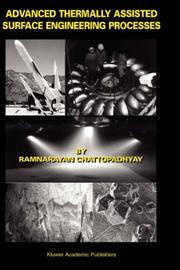| Listing 1 - 10 of 2430 | << page >> |
Sort by
|

ISBN: 1402077645 1402076967 Year: 2004 Publisher: Dordrecht Springer US
Abstract | Keywords | Export | Availability | Bookmark
 Loading...
Loading...Choose an application
- Reference Manager
- EndNote
- RefWorks (Direct export to RefWorks)
Book
ISBN: 9811657637 9811657629 Year: 2022 Publisher: Singapore : Springer,
Abstract | Keywords | Export | Availability | Bookmark
 Loading...
Loading...Choose an application
- Reference Manager
- EndNote
- RefWorks (Direct export to RefWorks)
Book
ISBN: 1837686688 Year: 2023 Publisher: London : IntechOpen,
Abstract | Keywords | Export | Availability | Bookmark
 Loading...
Loading...Choose an application
- Reference Manager
- EndNote
- RefWorks (Direct export to RefWorks)
Corrosion refers to the gradual degradation of materials. It occurs in both ferrous and non-ferrous metals. Rust, erosion, wear, galling, swelling, cracking, splitting, and decaying are known forms of degradation. A refined metal undergoes natural corrosion, which changes it into a more stable oxide. By reacting chemically or electrochemically with their surroundings, materials (often metals) slowly deteriorate. The discipline of corrosion engineering is focused on managing and avoiding corrosion. Some metals develop a natural corrosion resistance property known as passivity. This happens when the metal reacts with the oxygen in the air or corrodes in it. The ultimate result is a thin oxide sheet that prevents the metal from continuing to react. In general, corrosion is a process that turns refined metals into more stable substances like metal oxides, metal sulfides, or metal hydroxides. Similar to this, when iron rusts, oxygen and moisture in the air cause the development of iron oxides. According to the science of corrosion, metals transform into considerably more stable chemical compounds like oxides, sulfides, and hydroxides throughout this spontaneous and irreversible process. The book presents research on the basic and advanced aspects of corrosion.
Book
ISBN: 1906715173 9781906715175 Year: 2013 Publisher: Manchester: SurfaceSpectra,
Abstract | Keywords | Export | Availability | Bookmark
 Loading...
Loading...Choose an application
- Reference Manager
- EndNote
- RefWorks (Direct export to RefWorks)
Book
ISBN: 9780954953300 0954953304 Year: 2005 Publisher: Knutsford: Acolyte Science,
Abstract | Keywords | Export | Availability | Bookmark
 Loading...
Loading...Choose an application
- Reference Manager
- EndNote
- RefWorks (Direct export to RefWorks)
Book
Year: 1980 Publisher: Philadelphia: ASTM,
Abstract | Keywords | Export | Availability | Bookmark
 Loading...
Loading...Choose an application
- Reference Manager
- EndNote
- RefWorks (Direct export to RefWorks)
Multi
ISBN: 9780128148440 0128148446 9780128148433 Year: 2019 Publisher: Amsterdam, Netherlands : Elsevier,
Abstract | Keywords | Export | Availability | Bookmark
 Loading...
Loading...Choose an application
- Reference Manager
- EndNote
- RefWorks (Direct export to RefWorks)
Book
Year: 2019 Publisher: [Place of publication not identified] : MDPI - Multidisciplinary Digital Publishing Institute,
Abstract | Keywords | Export | Availability | Bookmark
 Loading...
Loading...Choose an application
- Reference Manager
- EndNote
- RefWorks (Direct export to RefWorks)
This book contains selected contributions on surface modification to improve the properties of solid materials. The surface properties are tailored either by functionalization, etching, or deposition of a thin coating. Functionalization is achieved by a brief treatment with non-equilibrium gaseous plasma containing suitable radicals that interact chemically with the material surface and thus enable the formation of rather stable functional groups. Etching is performed in order to modify the surface morphology. The etching parameters are selected in such a way that a rich morphology of the surfaces is achieved spontaneously on the sub-micrometer scale, without using masks. The combination of adequate surface morphology and functionalization of materials leads to superior surface properties which are particularly beneficial for the desired response upon incubation with biological matter. Alternatively, the materials are coated with a suitable thin film that is useful in various applications from food to aerospace industries.
Book
ISBN: 0901920037 Year: 1980 Publisher: Leicester Rank Taylor Hobson
Abstract | Keywords | Export | Availability | Bookmark
 Loading...
Loading...Choose an application
- Reference Manager
- EndNote
- RefWorks (Direct export to RefWorks)
Book
ISBN: 1523127643 3035735255 9783035735253 9783035715255 Year: 2019 Publisher: Zurich
Abstract | Keywords | Export | Availability | Bookmark
 Loading...
Loading...Choose an application
- Reference Manager
- EndNote
- RefWorks (Direct export to RefWorks)
| Listing 1 - 10 of 2430 | << page >> |
Sort by
|

 Search
Search Feedback
Feedback About UniCat
About UniCat  Help
Help News
News